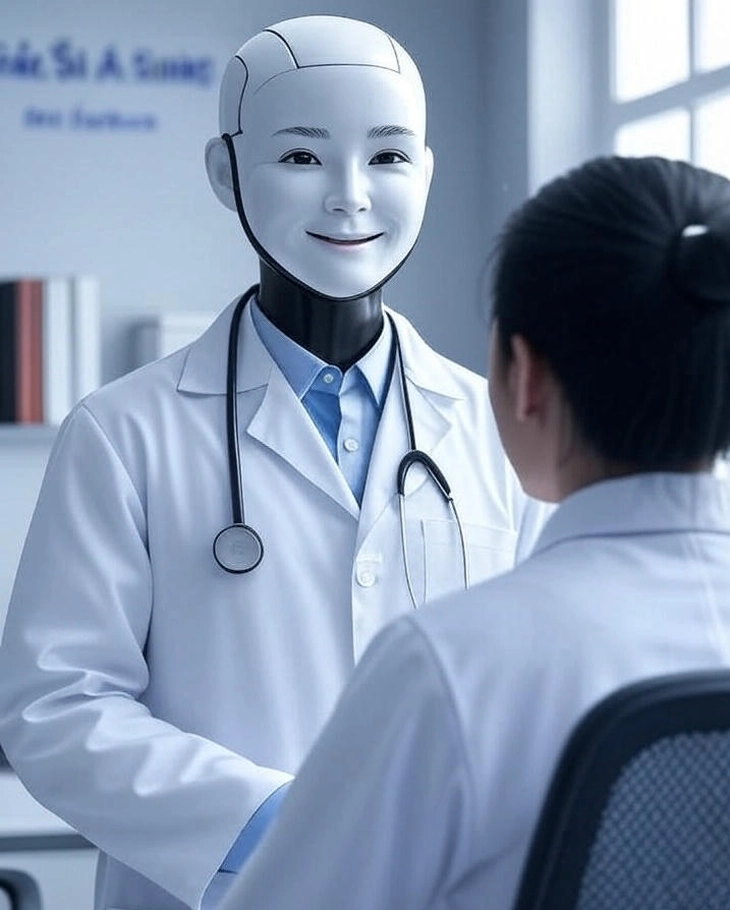
To use an AI doctor effectively, you need to understand its role: a support tool, not a real doctor.
Have you ever "asked Google" when you had a headache, stomachache or insomnia for no apparent reason? Nowadays, not only Google, but also artificial intelligence (AI) technologies are acting as a "virtual doctor" ready to give diagnosis, advice and even suggest treatment in just a few seconds.
But should we completely trust these "AI doctors"?
How does AI become a doctor?
Artificial intelligence in healthcare relies on the ability to analyze huge amounts of data from medical documents, patient records, symptoms, diagnostic images, and clinical research.
When you type in a description like: “Right side abdominal pain, mild fever, nausea,” the AI will quickly compare it with millions of similar cases and come up with a number of possibilities like appendicitis, digestive disorders, or intestinal infections.
Some popular medical AI systems today include:
Medical Chatbots: like HealthTap, Ada, Babylon Health or AI integrated in ChatGPT.
AI imaging diagnosis: reading X-rays, MRIs faster than doctors.
Clinical support system: supports doctors in developing treatment regimens.
Advantages of "AI doctor":
1. Convenient and fast
Instead of waiting hours at the hospital, you can get a preliminary assessment in just minutes. This is extremely useful for people in remote areas where specialist access is not easy.
2. Cost savings
Many AI applications are free or very low cost compared to private medical visits. For mild symptoms or monitoring chronic diseases, AI can significantly reduce medical costs.
3. Doctor support
AI can help doctors analyze data and detect signs that humans can easily miss. Many large hospitals are now using AI to help diagnose cancer, cardiovascular disease, or monitor critically ill patients.
4. 24/7 Accessibility
You can "ask for help" at any time - 3am or in the middle of a holiday - AI will still answer quickly and never get tired.
The risks of trusting "AI doctors" too much
1. Misdiagnosis or incomplete diagnosis
AI is only as good as the data and context it has. But sometimes people describe their symptoms incorrectly, lack detail, or enter the wrong information. In that case, AI can make a wrong or dangerous diagnosis. For example, chest pain could be due to bloating, but it could also be a heart attack!
2. No substitute for clinical experience
A real doctor not only relies on symptoms but also observes facial expressions, listens to heartbeats, and asks about medical history… These are things that AI cannot do at the moment. In addition, emotional factors, empathy, and communication are things that AI cannot replace.
3. Risk of self-treatment
Many users "ask AI" and then buy medicine to treat themselves, skipping doctor visits. This poses many risks, especially for serious or complicated illnesses. AI cannot prescribe medicine, and it cannot replace clinical testing.
4. Security and privacy issues
Health information is sensitive data. Entering personal symptoms into an AI system can lead to data breaches if not properly secured.
How to use medical AI properly?
Use AI as an aid, not a replacement for doctors.
Only trust licensed, reputable, and secure medical AI applications.
Use AI to learn more about your health, track mild symptoms, or better prepare for a real doctor's visit.
Always consult a medical professional before taking any medication or undergoing any treatment.
Trust but not blindly
AI doctors are a proud achievement of modern technology. They help open up opportunities for easier, faster, and lower-cost access to healthcare. However, trust in AI must be accompanied by understanding and responsibility.
Medical AI is not a "cure-all," but simply an intelligent assistant that helps you better understand your health and is a better stepping stone before seeing a real doctor.
Be a smart user: use AI properly to protect your health and that of your loved ones!
Source: https://tuoitre.vn/bi-benh-co-nen-kham-voi-bac-si-ai-2025060917532103.htm


![[Infographics] 3 policies and regimes for civil servants who voluntarily resign](https://vphoto.vietnam.vn/thumb/1200x675/vietnam/resource/IMAGE/2025/7/17/d3cb038a797042a4981647fceacd73b9)































































































Comment (0)